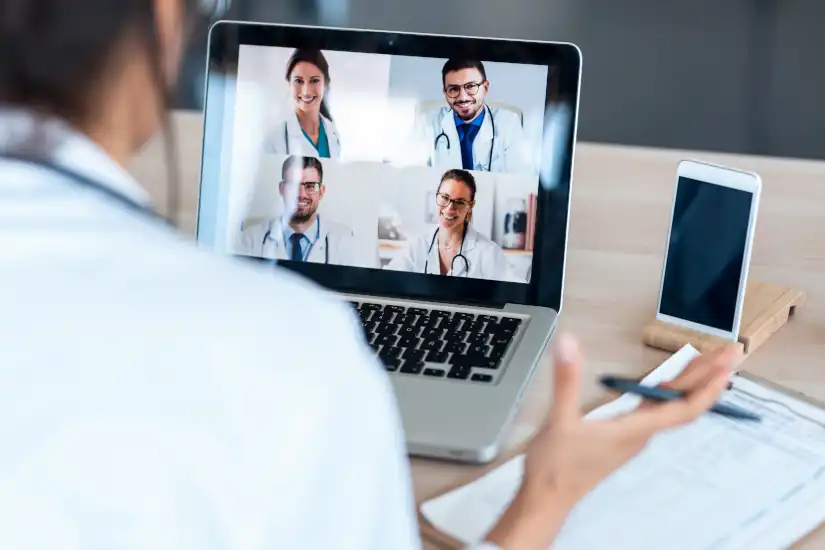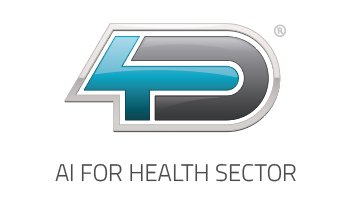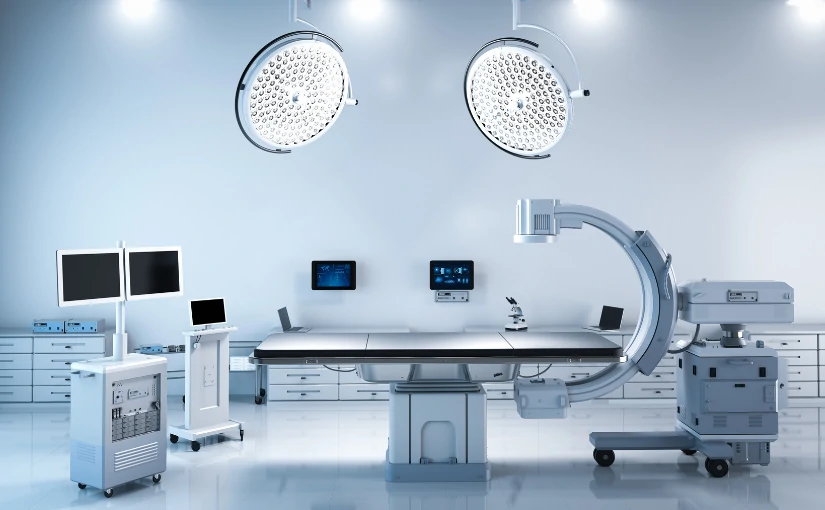
Telemedicine: What it is, how it works and its relationship to AI
In recent decades, the introduction of new technologies in the health sector has enabled the development of new forms of healthcare. It is becoming increasingly common for patients to receive a remote medical care by healthcare professionals, through video consultations, remote monitoring or digital diagnosis. This is what is known as telemedicine.
The main objective of the incorporation of new Information and Communication Technologies (ICT) in medicine was to bringing health services closer to the population who resided in remote regions and who had a reduced health accessibility and resources. Over the years and with the development of new technological innovations, including the emergence of artificial intelligence (AI), ICT became a key tool in the development to improve the quality and efficiency of healthcare.
What is it and how did it come about? In the following article, we explain what telemedicine is, how it works and its relationship with AI, as well as its different advantages and disadvantages.
What is telemedicine?
Telemedicine is the a set of medical practices that use information and communication technologies (ICT) to provide remote health care services.. This includes medical consultations, diagnoses, treatments, clinical follow-up, issuing prescriptions and preventive guidance, without the need for the patient and the professional to be physically present in the same place. For this purpose, telemedicine allows access to health services through electronic devices such as computers, tablets or smartphones, through secure digital platforms.
The World Health Organization (WHO) defines it as: "The provision of health services at a distance through the use of information and communication technologies for diagnosis, treatment, disease prevention and research."
Telemedicine and eHealth (digital health): What are their differences?
At the same time, the eHealth (digital health) conceptThe term "health informatics", which encompasses a broader term and is located between medical informatics, public health and commercial interest. It refers to the use of information and communication technologies (ICT) to improve, support and optimize the delivery of healthcare services and the management of the healthcare system.
Although often used synonymously, eHealth and telemedicine are not the same thing, although they are closely related. While eHealth telemedicine connects physicians and patients at a distance, eHealth encompasses all types of digital tools that improve health.. From an app to a hospital management system, such as the PACS system or the RIS system.
In this context, the telemedicine concept is part of the eHealth ecosystem. and focuses specifically on the provision of medical services, providing remote consultation, diagnosis and treatment.
Origin: Technological stages and evolution
Telemedicine is not a recent concept. Its origin dates back to the 1950s.The first remote communication systems began to be used for medical purposes. One of the first documented cases was in the United States, where a telephone line was used to transmit radiological images between hospitals. The following stages can be distinguished:
Early decades: 50's-70's
In the late 1960s, the NASA played a key role in the development of telemedicine. Faced with the need to be able to monitoring the health of astronauts during space missionsThe development of technologies capable of recording and transmitting biometric data remotely was promoted. These advances were also applied in rural Alaska through the STARPAHC (Space Technology Applied to Rural Papago Advanced Health Care) program, considered one of the first structured telemedicine projects.
Technological evolution: 1980s to 2000
During the 1980s and 1990s, the improvement of computer technology and satellite communications allowed the expansion of telemedicine services, especially in rural and military environments. The use of telemedicine systems for teleconsultation, remote diagnosis and exchange of clinical information between hospitals.
In these years, video calls started to be used for dermatology, psychiatry and radiology consultationsThe use of telemedicine was limited, however, by the high cost of equipment, lack of infrastructure and poor digitization of medical records. However, the use of telemedicine was limited by the high cost of equipment, the lack of infrastructure and the scarce digitalization of medical records.
Digitalization and the rise of the Internet: Years 2000-2010
With the the advent of the Internet, personal computers and smartphones.telemedicine took a qualitative leap forward. Starting in the 2000s, telemedicine began to develop more accessible platforms for online consultations, chronic patient follow-up, diagnostic test referrals and distance medical education. The first electronic medical record systems were also integrated, which facilitated networking among professionals from different health centers.
Telemedicine today
Although telemedicine was already in existence, the COVID-19 pandemic in 2020 marked a definitive turning point in its adoption worldwide. Faced with the need to avoid travel and minimize the risk of contagion, many healthcare systems began to offer video-call consultations, electronic prescriptions, remote monitoring and online psychological care. Today, telemedicine has established itself as a standard medical solution in many countries and has been integrated into public and private healthcare services.
The relationship between telemedicine and artificial intelligence
The development of the artificial intelligence in medicineIn recent years, remote monitoring devices and predictive algorithms are driving the rise of telemedicine. In recent years, the combination of telemedicine and artificial intelligence is transforming the way medical care is delivered to patients. Both technologies, when combined, improve the efficiency, accuracy and accessibility of the different healthcare services. However, although they are two complementary tools, each one has its own operation and its own specific characteristics. medical applications specific.
On the one hand, the telemedicine enables health care professionals to to care for patients remotely. On the other hand, the IA is responsible for analyze large volumes of medical data, detect patterns, automate tasks and suggest diagnoses or treatments.
Therefore, when used together, more agile, intelligent and personalized systems are created. At present, the use of AI software to improve the efficiency and accuracy of medical diagnosis, as well as facilitate patient management and healthcare.
Types of telemedicine: We analyze how it works and what it is used for.
Since the emergence of telemedicine and with the evolution of different technologies, different types of telemedicine have been developed that define the concept as we know it today. Below, we analyze how each of these modalities works and what they are used for:
Teleconsultation
The medical consultation represents the basis of clinical practice in the field of medicine. For this reason, teleconsultation is the most commonly used modality. It is based on the search for local or external medical information or medical advice, using information and communication technologies.
Communication between the patient and the healthcare professional can be done directly or through third parties. Thus, there are two different types of teleconsultation: asynchronous and synchronous.
-
Asynchronous teleconsulting
In this type of teleconsultation, known as asynchronous, medical care is provided by means of the The physician will send clinical information and, subsequently, the physician performs the assessment and counseling.
Main advantages
- The parties involved do not have to be present at the transfer of information.
- It offers the ability to capture and store still and moving images of the patient, as well as audio and text, providing the healthcare professional with more clinical information.
- It is an economical and accessible modality, since it supports a large volume of work and analysis of medical tests.
-
Synchronous teleconsultation
Synchronous teleconsultation is developed in real timeand, therefore involves the participation of patients and health care professionals in sending information through the use of telecommunication technologies.
In this modality, videoconferencing stands out as the most commonly used technologyIt provides both visual and auditory contact with the patient. This facilitates pattern recognition and greater accuracy in making a medical diagnosis.
Main advantages
- Fast and effective diagnosis
- Better understanding between patients and professionals health care
- Integration of additional techniques that increase reliability
of clinical information. This is the case of digital auscultation.
Main disadvantages
- Its execution involves a number of huge costs economically, since it requires a certain telecommunication infrastructure.
- Requires a increased demands on the time of medical professionals, as they must allocate time for the teleconsultation and, additionally, carry out a pre- and post-evaluation.
Teleeducation
It is defined as the use of information and telecommunication technologies for distance medical education practice. In this field, Internet technologies and videoconferencing are the means most commonly used by health professionals to increase their skills and put their knowledge into practice. Within tele-education, different modalities can be distinguished, depending on the way in which the information is transmitted:
-
Tele-education through teleconsulting
A physician who is an expert in a particular specialty provides a diagnosis to the query raised by a non-expert physicianintern or resident.
-
Clinical education via the Internet
Allows the access to various databases with medical and clinical articles and books. These include MedLine, Cochrane, the National Library of Medicine in the United States and the National Electronic Health Library in the United Kingdom.
-
Academic studies via Internet
Different universities, both public and private, offer courses and tele-educational programs, as well as virtual internships., where participants are evaluated and graded to obtain a set of competencies that will allow them to develop their professional career in the health area.
-
Public education through telemedicine
Refers to the medical education and communication offered on different topics related to public health. From diet, exercise and hygiene websites to different diseases, such as cancer and AIDS.
Telemonitoring
Telemonitoring is the use of information and communication technologies to obtain information regarding the patient's condition and status to determine if adjustments or changes to the proposed treatments are necessary.
This type of telemedicine allows professionals to monitor different aspects: physiological variables, test results, as well as images and sounds. It is usually performed at the patient's home or in nursing centers, which reduces costs and resources for the healthcare system.
Telesurgery
Telesurgery is based on the development and execution of surgeries where the surgeon acts by means of remote visualization and manipulation using electronic devices and high technology in telecommunications. The main objective of telesurgery is to offer surgical services to patients who, for reasons of inaccessibility, cannot be attended in person in hospitals and medical clinics. Telesurgery has two different modalities, which are discussed below:
-
Tele-surgery through tele-education or telementoring
Telesurgery by means of tele-education or telementoring is an advanced form of remote surgical training and medical care that combines telecommunications technology, real-time surgery and medical teaching techniques.
The telesurgery by means of telementoring is that a skilled surgeon (mentor) provides technical advice, corrections, instructions or live training during a surgical procedure being performed by a less experienced surgeon (trainee)even if they are in different geographical locations. This is achieved by means of videoconferencing systems, augmented reality, laparoscopic cameras or interactive platforms.
For its part, the surgical tele-education goes beyond the operating room and encompasses also theory sessions, case review, virtual classes and guided surgical simulationall from a distance.
-
Telepresential surgery
Telepresential surgery is an advanced modality of technology-assisted surgery that enables a surgeon to control surgical instruments remotely using robotic systems connected by high-speed telecommunications networks.
This is a form of telesurgery and allows the professional to act as if he were in the operating room through the use of technology. For example, the use of robotic arms, micro cameras and high resolution optical instruments.
Advantages and disadvantages of telemedicine
| Advantages of telemedicine | Disadvantages of telemedicine |
|---|---|
| Facilitates access to medical care from any location | Does not allow complete physical examinations |
| Reduces travel and waiting times | Dependence on devices and good internet connection |
| Saves costs for patients and healthcare facilities | Digital barriers may exist for the elderly or people with few resources |
| Improved follow-up of chronic patients | Some specialties are not compatible (e.g. surgery, dentistry). |
| Promotes continuity of care and preventive care | Loss of human and nonverbal contact in the doctor-patient relationship. |
| Contributes to sustainability by reducing carbon footprint | Medical data security and privacy risks |
Main advantages of telemedicine
Telemedicine and technological innovations in the healthcare field have provided a number of benefits, driving the improvement of healthcare and medical diagnosis.
Access to health care from anywhere
Telemedicine makes it easier to people living in rural areas, with limited health care resources or with reduced mobility can receive medical care without the need to travel. In this way, it is characterized by bringing medical care closer to different groups. From the elderly and migrant population to patients with disabilities, which improves health equity.
Time savings and convenience
Avoids trips to health centers or hospitals and eliminates waiting times in consultation rooms. The patient can perform consultations from home, obtaining greater time flexibility and without interrupting his or her daily routine. On the other hand, consultations are shorter and more directThe work of healthcare professionals is optimized.
Cost reduction
It reduces costs for both patients and health centers. On the one hand, patients avoid the expenses associated with transportation, permit applications labor andIn many cases, it is also reduces the cost of consultation. And, for health centers, it represents a significant saving by reducing the need for physical infrastructure, logistical resources and on-site personnel. Thus, it favors the efficiency of the public and private system.
Effective chronic disease monitoring
Allows you to real-time patient monitoring with pathologies such as diabetes or hypertension, avoiding complications and improving adherence to treatment.
Better doctor-patient communication
Promotes a closer and continuous careThe system is ideal for resolving doubts, reviewing tests or following up with the patient without having to visit the health center in person.
Optimization of the healthcare system
Reduces the burden on emergency and primary care by filtering non-urgent consultations and improving medical resource management.
Positive impact on the environment
By reducing the number of trips, we also carbon footprint is reduced associated with medical care.
Boosting digital health and education
Allows to integrate educational content and interactive resources to assist the patient to take care of your health from home. And, at the same time, it makes the medical training for professionals through tele-education.
Greater control and security
Digital platforms protect the patient privacy and generate a electronic medical record with better traceability and follow-up. In this way, patients can consult their records, tests and treatments digitally.
Disadvantages and limitations of telemedicine
Although telemedicine offers numerous benefits, it also presents a number of limitations and challenges:
Direct physical examinations are not possible
The main limitation is that direct physical examinations are not permitted, which can make diagnosis difficult in complex or urgent cases. Some diseases require palpation, auscultation or immediate tests that can only be done through a face-to-face consultation.
Technology dependence and digital divide
For telemedicine to work properly, it is necessary to have a good Internet connection, the use of appropriate medical devices and knowledge of the use of digital applications. Not everyone has access to digital tools or the Internet. This may exclude older people or those with limited technological resources.
Difficulties in the patient-physician relationship
Physical contact and nonverbal communication are key in the clinical relationship. In some cases, telemedicine may lead to a feeling of distance or lack of empathy between health professionals and patientsespecially in consultations with sensitive diagnoses.
Data privacy and security risks
The use of digital platforms entails risks of leakage or misuse of personal and medical information if the following guidelines are not applied. appropriate cybersecurity measures.
Technical limitations and connection failures
Technical problems such as network outages, poor image or sound quality, as well as software malfunctions can interrupt or hinder consultations, affecting the quality of service.
Restrictions on certain medical specialties
Not all areas of medicine are well suited to the virtual environment. For example, surgery, traumatology or dentistry require mandatory physical presence, and telemedicine can only complement some processes, not replace them.
Telemedicine represents the combination of technology and health services. Over the years, its evolution has driven an increasingly complete and efficient healthcare system. In this context, the relationship between telemedicine and artificial intelligence stands out, since it offers a higher quality of health careThe aim is to provide a more accurate medical diagnosis and the development of medical treatments customized to the real needs of patients.
Bibliography
Torres, M. R. R. R., & Collado, M. E. M. (2016). Telemedicine: Current status and perspectives. Clínica Las Condes Medical Journal, 27(5), 571-577. https://doi.org/10.1016/j.rmclc.2016.09.003
Peña González, A., & Córdova Alcaraz, L. (2017). Application of telemedicine in primary health care. Cuban Journal of Information in Health Sciences (ACIMED), 28(2), 135-145. https://www.redalyc.org/pdf/2611/261120984009.pdf
Sánchez-Guzmán, M. A., & González, S. M. (2015). Telemedicine: technological innovation in health. Iberoamerican Journal of Educational Research and Development, 6(12), 1-16. https://www.redalyc.org/pdf/2310/231019866002.pdf



